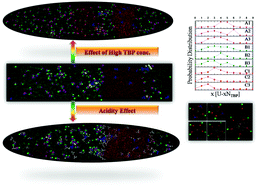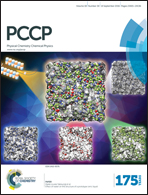Passage of TBP–uranyl complexes from aqueous–organic interface to the organic phase: insights from molecular dynamics simulation†
Abstract
The present study reports molecular dynamics simulations for biphasic systems comprising tributyl phosphate (TBP) in dodecane and uranyl nitrate in the aqueous phase, which are key chemical species in the well-known Pu–U extraction (PUREX) process. An attempt has been made to understand the nature of interface and mechanism of ‘TBP associated uranyl’ crossing under neutral and acidic conditions. Results show that the solvent density undergoes large fluctuation near the interface depending on the nature of the aqueous–organic phase. The study provides compelling evidence of experimentally observed reorganization of interfacial complexes at the interface and their structural reformation during extraction. It has been observed that the surface active nature of TBP and their interfacial coverage is modulated by the nature of incorporated solute species and their location with respect to the interface. Also, the TBP structuring near the interface is destroyed when an acidic interface is considered rather than a neutral one which favors the uranyl extraction. With an acidic interface, the water humidity of organic phase was observed to be increased in the experiments. Furthermore, the acid/water solubility in the organic phase was observed to be influenced by selection of acid models and their concentration. Simulations with high acid concentration show water pocket formation in the organic phase. However, in the case of dissociated ions or a mixture of both, no such water pool is observed and the extracted water remains dispersed in the organic phase, having the tendency to be replaced by HNO3 because of preferred TBP·HNO3 complexation over TBP·H2O. Most remarkably, the present study makes evident the TBP-induced charge redistribution of uranyl complexes during migration from the interface to the bulk organic phase, which contributes to drive uranyl complexes such as UO2·NO3·4TBP, UO2·5TBP and UO2·NO3·3TBP·HNO3 in the organic phase, and this was reestablished by DFT calculations. Thus, the present study inspires future simulation and experimental investigations on the extraction of species at the liquid–liquid interface.


 Please wait while we load your content...
Please wait while we load your content...